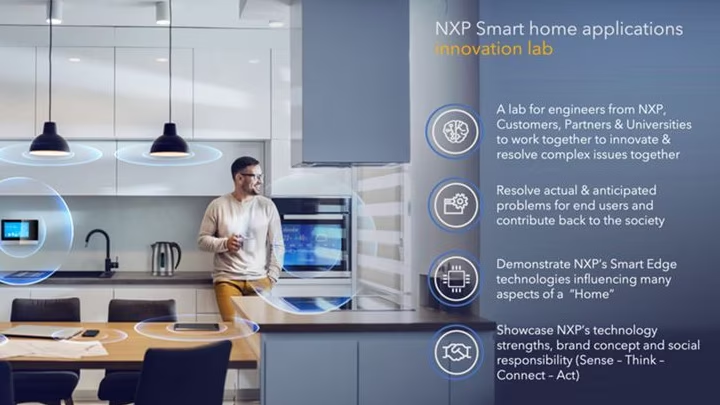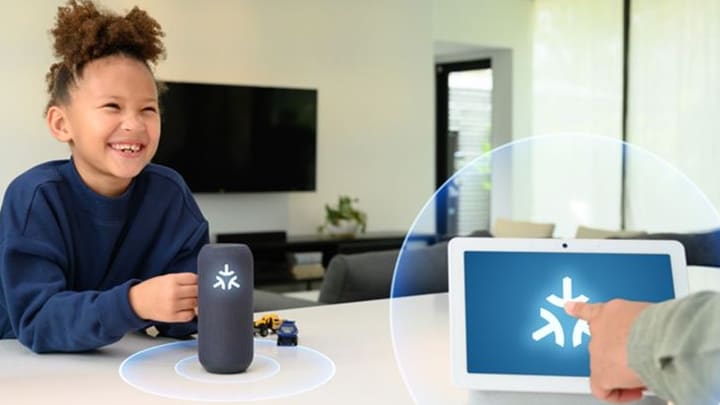NXP Smart Home Innovation Lab,based in Austin, Texas, is a hub of innovation and collaboration where we and our partners are making the Smart Home of today become the Autonomous Home of tomorrow.
A Better Life at Home
As George Davison puts it at the beginning of the show, semiconductors are getting smaller and smaller, and that means the opportunities for innovation are getting bigger and bigger. As far as connected living spaces and home automation are concerned, that means semiconductors are being used in new ways to make life at home easier, healthier, safer, and more enjoyable.
The Tomorrow’s World Today crew paid a visit to our innovation lab in Austin, and I showed them around. We took a peek behind the scenes and had our NXP team demonstrate some of the home automation innovations we’re helping customers bring to market. We also spent some time in Inventionland, George Davison’s purpose-built work environment for technical innovation and invention, to talk about more ways semiconductors are helping people at home and away.

Secure, Sustainable, and Healthy
Here are just a few of the solutions highlighted in the 20-minute show:
Safety and Security
Sensors, placed throughout the house, enable autonomous features that work to protect home and property. The house becomes occupancy aware – meaning it can tell who is home and where they are – and can anticipate what needs to happen as a result. For example, your front door can recognize you when you come home, and automatically unlock the entrance, without forcing you to use a mechanical key or a digital keypad, and then lock it again once you’re inside. Using NXP’s high-level security solutions – the same algorithms used by banks and retailers to protect financial transactions – the entryway can confirm your identity and verify your authorization to access the home.
NXP is paving the way for the Smart Home of the future. Transform the home experience with our scalable, energy-efficient and secure-by-design solutions
Those same security features can be used to keep people safe once they’re inside the home. The kitchen may be a gathering place for friends and family, but it’s also a part of the house filled with potentially dangerous situations. Autonomous security features that support smart access can prevent a toddler from accidentally turning on the cooktop. At the same time, sensors capable of detecting too-high temperatures, and cameras that detect smoke or check whether people are still in the kitchen while the cooktop is on, can prevent other serious accidents, including fires.
When the house knows how’s present, and can report location, it’s easier to protect the vulnerable and ensure they remain out of harm’s way. Being able to confirm that an aging parent is still with their caretaker, or receive an alert if a small child has managed to climb out of their playpen, helps keep everyone safe.
Advanced human-machine interfaces (HMIs), make it easy to configure and control these autonomous features, so it’s simple to add new security features and change settings, or even assign temporary authorizations when service people or guests need access to the home.
Sustainability
Working behind the scenes, many autonomous features help reduce waste and increase efficiency, especially when it comes to scarce resources like energy and water. An autonomous house can sense your presence and movements, and respond to your activities by automatically doing things like turning lights on and off, transferring entertainment to different screens and speakers, or setting the temperature to your liking. Sensors can also detect if there’s a water leak and quickly shut it off before it causes damage and requires an expensive repair.
Autonomous features can even be used to create a home that doesn’t require external energy. In houses equipped with solar panels, you can optimize how you generate and store power, and increase the efficiency of electricity storage. Excess energy can be stored in onsite batteries and used to charge a vehicle. With bidirectional EV charging, the vehicle can also be configured to send power back to the house, for emergency power during an outage.
Health and Wellness
Home is meant to be a place where we can relax and recharge. Autonomous features help create a sanctuary of health and wellness, with sensors that do things like monitor air quality and send an alert if levels fall beneath specified thresholds. Lights can automatically change to blue-light filtering when bedtime approaches, to enable more restful sleep.
Another way technology helps maintain wellness, at home and away, is with smart wearables that support good health. A real-time blood-glucose monitor, for example, automates insulin injections so people with diabetes have the freedom to live life without stopping for blood tests and shots.
Master Control with Matter
All these autonomous features can be controlled using a single, easy-to-use dashboard, accessible from whichever device is most convenient, be it your phone, your tablet, TV, or refrigerator. The technology that ties them all together is Matter, a standard that NXP helped define. Matter provides a universal language for all the devices in the home, from tiny sensors to major appliances. There’s no need for cumbersome translators, so there’s more choice when considering what to install, and installation is both faster and easier. Matter means you can always see how the house is doing as a whole, and make adjustments as necessary or modify the house to your personal preferences. Matter makes the automated home possible, and ensures that new features are both easy to deploy and easy to use.

Precise Location with UWB
Another key technology in the autonomous home is Ultra-Wideband (UWB), a wireless technology that can detect location to within 10 cm (4 inches) and supports radar features that gauge small changes in direction. UWB makes it possible to know where people are, with a high degree of precision, and movement. UWB is what lets lights and blinds respond to your presence, and makes entryways lock or unlock, depending on whether you’re moving away or toward the door.
Beyond Smart Home
A number of other market segments besides the home, including industrial, medical and automotive, need similar levels of security and sustainability, which means many of the innovative solutions we demonstrated for Tomorrow’s World Today are being used in other markets, too. Whether it’s adding automation on the factory floor, providing patients with more automated ways to monitor their health, or creating vehicles that enable safer, more efficient driving, NXP is putting innovation to work, for a better tomorrow.

